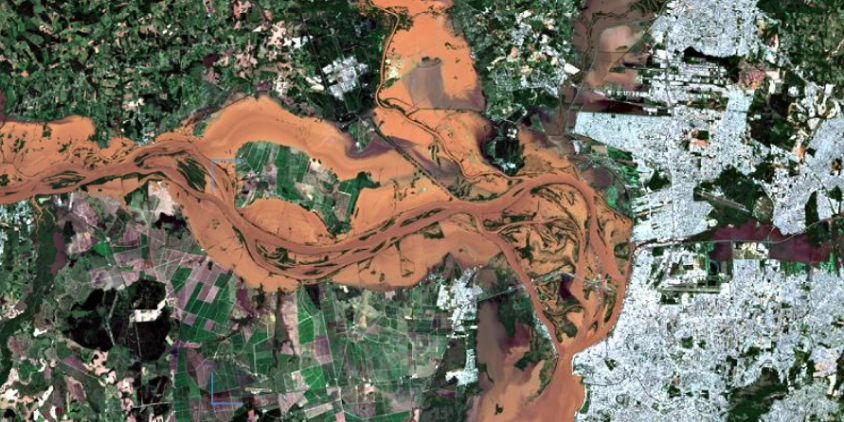
Natural Disasters 2023: Year Of Tragic Record-Breaking
Every year, it seems like we’re repeating the same old refrain: climate change is making natural disasters more common and devastating. How many natural disasters were there in 2023? A whopping number of around 240 calamities worldwide.
The natural disasters of 2023 had a particularly devastating effect on rural and developing nations, mainly because of logistical issues, protection gaps, and difficulties in supplying basic needs due to water pollution and crop losses. Now, 2023 is the year of record-breaking deadly catastrophes. But if we all pitch in and leverage modern technologies to address climate change and create mitigation strategies, we have a chance to make 2023 the last year natural disasters hit that hard.
Also read the natural disasters 2024 recap.
Natural Disasters 2023: Wildfires
Although wildfires occur normally in many ecosystems, global warming and related extreme weather phenomena are making them more frequent and extensive. Wildfires in 2023 were the worst on record in many regions, leading to devastating economic and environmental damage and human lives lost. The increasing threat from these 2023 natural disasters highlights the need for decisive solutions and joint action to prevent wildfires.
Wildfires In Hawaii
Parts of the Hawaiian island of Maui were engulfed in flames in August 2023 by a string of wildfires. Lahaina town was the most severely affected by the natural disaster that broke out on August 8, destroying nearly all of the town’s structures. According to reports, the wildfires in Lahaina were the deadliest in the US in over a hundred years. Beginning on August 9, 2023 several less destructive natural disasters of this kind engulfed other parts of Hawaii.
Costs for recovery in Lahaina were initially estimated at $5.52 billion . Such an extent of devastation could not be expected, but a wildfire itself could. For years, public safety authorities and scientists had warned of the dangers of wildfires owing to dryness, exacerbated by the island’s rising population. To defuse this ticking bomb and forestall such natural disasters in the future, deliberate collaboration was and is required. Live satellite images from EOSDA LandViewer can greatly support these disaster management and prevention efforts.
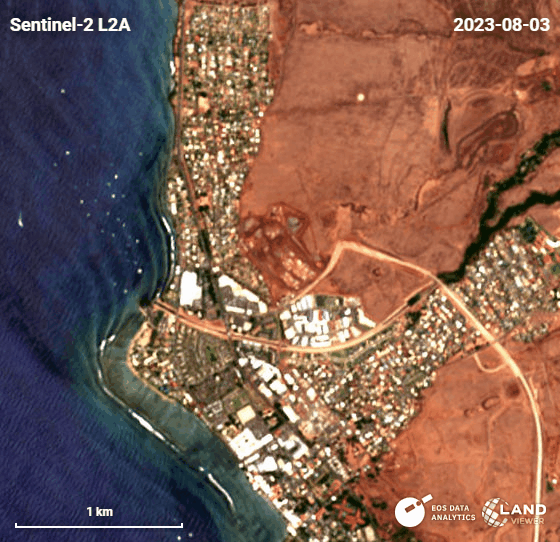
Wildfires In North Africa
In summer 2023, several regions of Algeria went through scorching temperatures, reaching 118°F (48°C). Following this, North African wildfires broke out on July 24th, mainly in El Taref Province, Algeria, resulting in 34 casualties and thousands of injuries from flames and smoke. Other countries in the region, including Tunisia and Morocco, also experienced the natural disaster.
As a result of the North African natural disasters in 2023, numerous households have been wiped out, forcing families out of their homes and into a precarious situation. The impacted communities depend heavily on agriculture, which has suffered significant losses due to the wildfires, leading to increased challenges for the locals’ livelihoods.
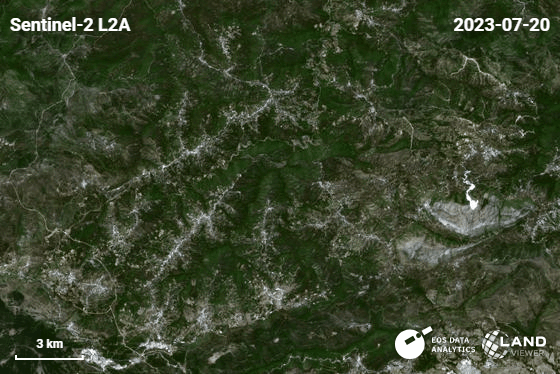
Wildfires In Greece
A protracted heatwave with temperatures reaching 105.8°F (41.0°C) has been sweeping Greece, sparking many wildfires since July 17, 2023. More than 80 wildfires have been registered, and at least 28 people have died as a result of these natural disasters.
Damage from the 2023 natural disasters extended throughout Greece, including the territories of Alexandroupolis, Corfu, Attica, Magnesia, Evia, and Rhodes. The majority of the burnt land is located in Dadia National Park, which is home to a large population of black vultures and is the largest Natura 2000 site in Greece. With an estimated 432 thousand acres (175 thousand hectares) charred, the wildfires were reportedly the biggest documented in this region thus far .
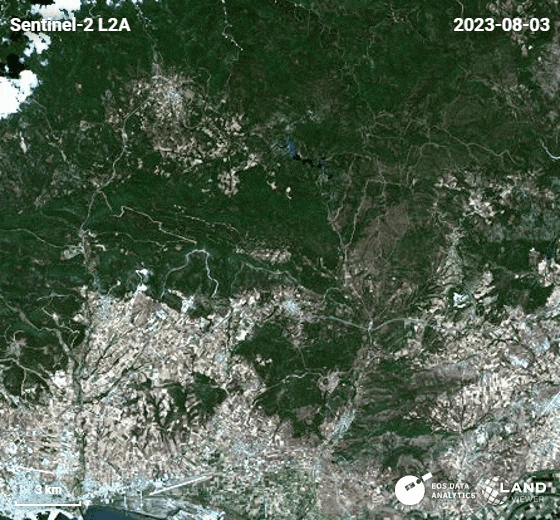
Natural Disasters 2023: Floods
Once thought to be entirely the result of natural causes, floods today are much more influenced by human actions. The frequency and severity of floods have seen a rise due to the global trend of urbanization, industrialization, and the extraction of natural resources. In 2023, this kind of natural disasters hit almost every part of the globe, with some of the worst occurring in the Congo, Chile, the United States, and Brazil.
Floods In The Democratic Republic Of The Congo
Beginning in early May, the eastern part of the Democratic Republic of the Congo (DRC) experienced heavy rains, which led to floods and mudslides. The overflowing rivers have flooded villages, resulting in over 450 fatalities and more than 2,000 people missing. Heavy rains during this, one of the world’s worst natural disasters of 2023, have rendered major roads leading to Nyamukubi, Bushushu, and Rambira villages inaccessible, causing delays in emergency response operations. The frequency and severity of extreme rainfall events and related natural disasters in Africa have been on the rise in recent years, and this trend is expected to continue as a result of global warming if no strategic action is taken.
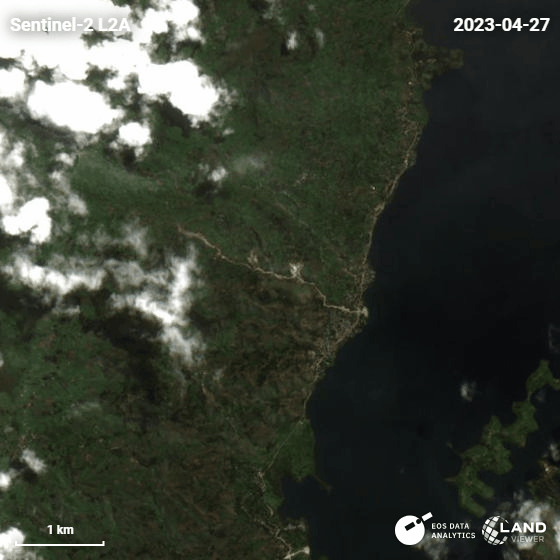
Flooding In Chile
Since June 21, Chile has been experiencing the most severe weather front in the last 10 years, with days of heavy rains overflowing rivers and causing devastating floods . A recent natural disaster in 2023 primarily impacted rural communities in southern and central Chile, affecting over 21 thousand people. Aside from houses and infrastructure, the natural disaster has also severely damaged crops. Water and power supplies have likewise been disrupted. Ultimately, on June 24, the flooding from Valparaíso to Biobío regions was officially designated a catastrophe by the government.
The most tragic part is that the 2023 natural disaster is likely not the last one to strike this area, as climate change continues to contribute to increasingly extreme weather events. Indicatively, the rains in Chile have come shortly after a drought and a devastating period of forest fires that killed scores of people and destroyed hundreds of dwellings.
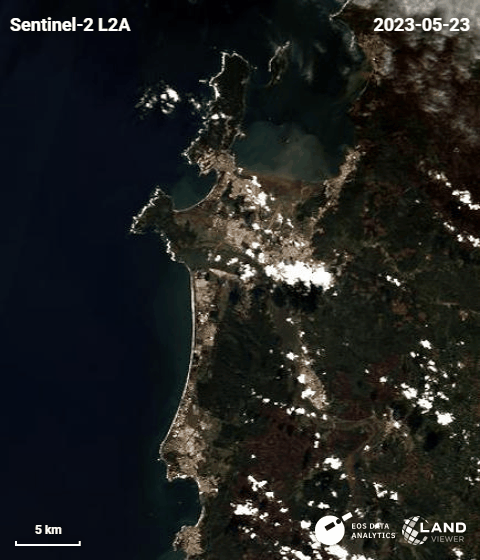
California Floods
From January to April 2023, California experienced heavy rains brought by atmospheric rivers. More than 200 thousand homes and companies in California suffered from the 2023 natural disaster, leading to the evacuation of around 6 thousand people. In addition to damaging property, the floods claimed the lives of at least 22 people.
Many news outlets in 2023 used this natural disaster to illustrate how climate change is causing more extreme weather events, particularly in terms of the frequency and severity of droughts and floods. Scientists predict that greater rain-to-snow ratios, shorter snowmelt periods, and more fierce storms and other natural disasters will make managing California’s water supplies significantly more complex.
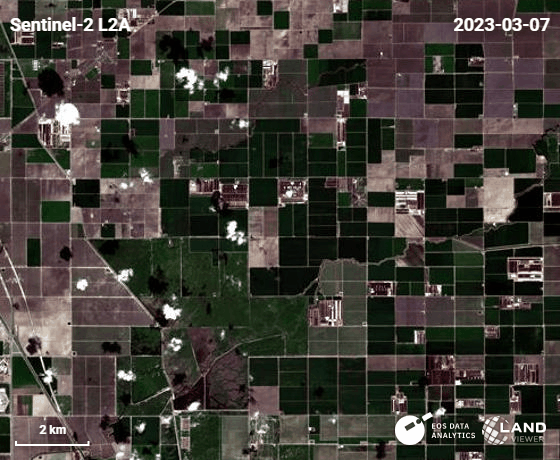
Flash Floods And Landslides In Brazil
Severe, record-breaking rainfall hit the Brazilian state of São Paulo on February 19. In one day, some areas received almost 26 inches (680 mm) of precipitation. The rainwater soaked the ground, resulting in devastating floods and landslides across the area.
Landslides blocked major roadways in the region. Flash floods had devastating effects on substandard houses, particularly in hillside areas. There have been 64 confirmed deaths due to the 2023 natural disasters in Brazil, with the overwhelming majority in the seaside city of São Sebastião. The most recent report from the Intergovernmental Panel on Climate Change (IPCC) emphasizes the strong belief that southern Brazil’s mean yearly rainfall would rise, which poses a greater threat of floods to the most densely populated regions of Brazil .
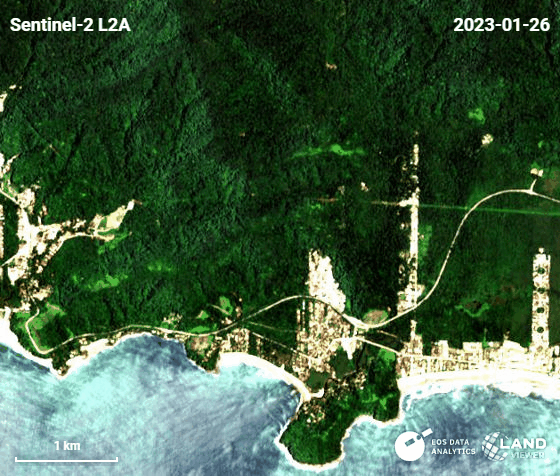
Natural Disasters 2023: Earthquakes
Over 15 thousand earthquakes were recorded in 2023. There were significant geological movements that year, as 147 earthquakes registered 6.0 or higher on the Richter scale. Now, let’s take a look back at the strongest 2023 natural disasters of this kind in the world.
Turkey–Syria Earthquakes
On February 6, an earthquake of 7.8 magnitude with an epicenter 23 miles (37 km) northwest of Gaziantep shook southeast Turkey, close to the border with Syria. After a few hours, the 2023 natural disaster in Turkey was exacerbated by a 7.5-magnitude aftershock and several smaller earthquakes. An area of around 86.5 million acres (350 thousand square kilometers) was severely damaged. The already dire humanitarian situation in Syria became even worse because of the natural disaster. Over 55,000 people, primarily of Turkish descent, perished in the earthquake. Even now, one year after this 2023 natural disaster, locals continue to struggle with its devastating repercussions.
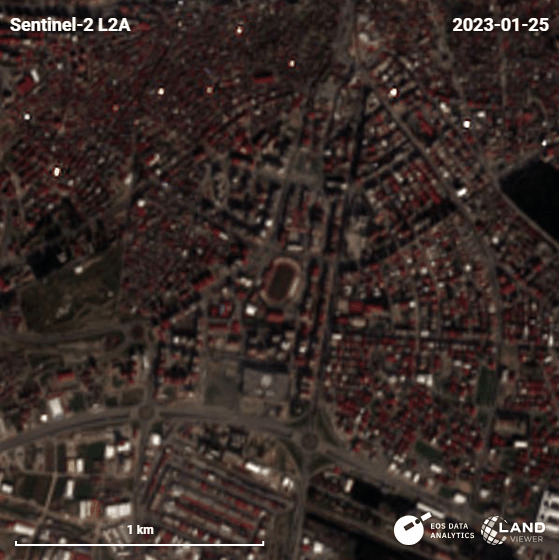
Marrakesh-Safi Earthquake
On September 8, 2023, a 6.9-magnitude earthquake with an epicenter 45.6 miles (73.4 km) southwest of Marrakesh hit Al Haouz Province in Morocco. The Atlas Mountains have never seen an earthquake this strong. Almost 3,000 people lost their lives in this 2023 natural disaster. Damage was extensive, and many historic sites in Marrakesh were destroyed, due to the city’s preponderance of ancient buildings and the prevalence of earthen construction in agricultural regions near the disaster’s epicenter.
EOSDA LandViewer
Perform satellite mapping of any large area via specialized GIS tools available in one of the largest catalogs of free satellite images.
Natural Disasters 2023: Cyclones And Storms
Storms and cyclones are not rare natural disasters. However, 2023 has been distinctive, with five extremely dangerous tropical cyclones, including Freddy and Mocha, from January through May. The economic losses from these 2023 natural disasters in the world far outweigh the insurance coverage, including crop insurance, revealing a significant protection gap in many regions prone to tropical storms. The record-high global sea surface temperatures observed in the first six months of 2023 might be one reason for this year’s early-season activity spike .
Tropical Cyclone Mocha
In May, Myanmar and partly Bangladesh were hit by cyclone Mocha, a severe North Indian Ocean tropical storm. 145 people, mostly members of the oppressed Rohingya minority, lost their lives when the natural disaster pounded Myanmar with winds reaching 130 mph (209 kph) and flash floods. The Southeast Asian nation endured not only one of the biggest natural disasters in 2023 but also one of the worst storms in recent memory.
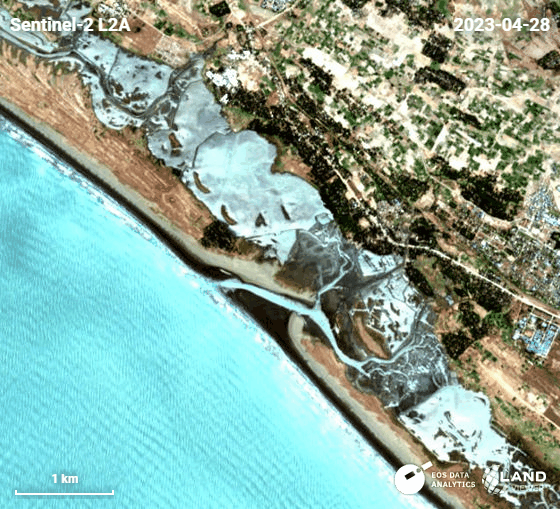
Storm Daniel
Greek, Turkish, Bulgarian, and Libyan coastal towns were hit hard by Storm Daniel on September 10, which resulted in catastrophic flooding. The natural disaster wreaked havoc on Greece, destroying infrastructure and the major agricultural region, Thessaly, and killing at least 17 people and over 200,000 animals.
Nearly 6.6 billion gallons (30 million cubic meters) of water were spilled all at once when the Derna and Mansour dams in Libya fell. Officially, 4,352 people have died as a result of the demolition of entire neighborhoods. This natural disaster in Libya in 2023 was particularly destructive because of a confluence of circumstances, including growing storm intensity, outdated infrastructure, and susceptible topography.
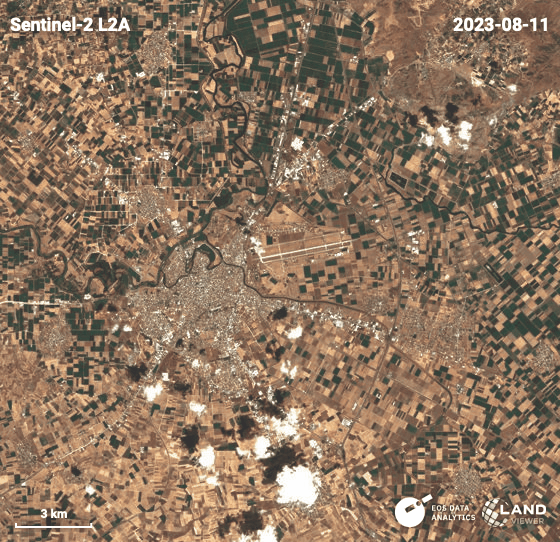
Tropical Cyclone Freddy
Tropical cyclone Freddy — fierce, devastating, and extraordinarily long-lived 2023 natural disaster largely caused by climate change — lasted over five weeks in the southern Indian Ocean. On February 21, the storm hit Madagascar’s eastern coast. The natural disaster wreaked havoc as it moved across the area west-southwestward, with its eye positioned around Malawi’s southern border with Mozambique.
In early March, the storm pounded Malawi with severe six-day rainfall, killing almost 700 people. Even though most of the damage from the natural disaster occurred in Malawi, other southern African nations were also hit hard; 184 thousand people were forced to leave their homes in Mozambique alone.
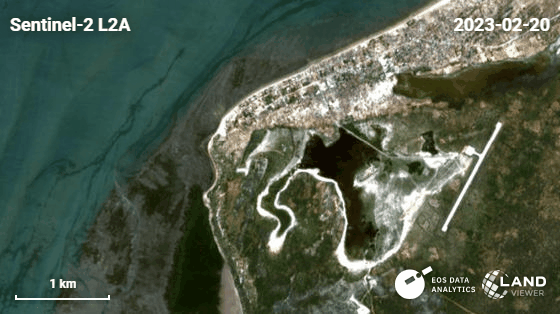
EOSDA LandViewer To Study And Mitigate Natural Disasters
When it comes to natural disaster management, satellites, with their continuous and all-encompassing view from orbit, are a lifesaver for monitoring even the most inaccessible places and tracking changes over time. Combining satellite-derived data with geographic information systems (GIS) yields a wealth of information useful for studying natural disasters, no matter how big or small. This can aid in detecting vulnerable areas, predicting disasters, strategic planning for their management, assessing damage, and prioritizing mitigation efforts.
Among the many satellite imagery platforms, EOSDA LandViewer stands out as an affordable and easy-to-use tool. It helps solve real-world problems on a global and local scale by drawing insights from data collected from variable sources. The EOSDA LandViewer satellite imagery can lend a helping hand to government and non-government organizations in remote sensing data analysis and mitigation efforts following natural disasters, including:
- environmental and climate monitoring;
- assessing the impacts of climate change;
- supporting ecological research;
- carbon management;
- water resources management;
- city planning;
- hazard mitigation;
- damage and loss assessment;
- emergency response.
Satellite imagery, used in tandem with existing modeling capabilities, has the potential to revolutionize how we monitor natural disasters, study their causes, and coordinate efforts to minimize their impact in the long run. With this, 2023 natural disasters around the world might become a turning point in global frequency and intensity, following which they will gradually diminish.
About the author:
Petro Kogut has a PhD in Physics and Mathematics and is the author of multiple scientific publications. He is the Soros Associated Professor as well as the head of the department of differential equations in the Oles Honchar Dnipro National University and has received a number of grants, prizes, honorary decorations, medals, and other awards. Prof. Dr. Petro Kogut is a science advisor for EOSDA.
Recent articles

Analyze 2025 & Plan Your Best Year Yet: LandViewer Christmas Offer
It’s the most wonderful time of the year! The Christmas holidays are here, and so is your chance to analyze 2025 and plan a prosperous 2026 with more affordable Pro plans in LandViewer.

EOSDA Models Climate Change Impact On Sugarcane Yields
EOSDA modeled future temperature, rainfall, and other climate impacts on Veracruz sugarcane. The results help growers plan long-term adaptation strategies, including timing, varieties, and irrigation.

EOSDA LandViewer Black Friday Sale: Exclusive Offers & Giveaway
This Black Friday, LandViewer offers new users the chance to save on monthly plans, get extra months with yearly subscriptions, and participate in a free annual plan giveaway.

